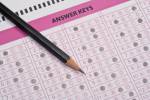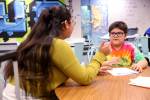COMMENTARY: China’s math memorization method adds up to higher scores
Here’s a shout out to fellow gray-hairs who learned math the “old-fashioned” way, by memorizing simple formulas along with facts about addition and multiplication. This technique is anathema in today’s classrooms.
But might the old ways ever come back into vogue?
I would have said, “When pigs fly,” but then I read Lenora Chu’s can’t-put-down book “Little Soldiers: An American Boy, a Chinese School, and the Global Race to Achieve.” Chu writes about her firsthand experience with the alarming — and ultimately effective — Chinese way of educating children.
The secret is, obviously, that it’s a test-crazy country. But those tests are laid upon such foundational principles as reverence for teachers, respect for math and a firm belief in the transformative power of hard work. According to Chu, doing well in school is “the ultimate way to respect your parents, since good grades and test scores are the path to financial stability, and the ability to provide for” parents in old age.
A child’s obedience to and respect for elders transfers to teachers, whose authority is absolute and never questioned — not even by Western parents who, like Chu, believe children should be given at least some measure of autonomy over themselves in order to mature and learn at their own pace.
The Chinese believe in luck and fate, but their guiding philosophy is that anything is possible if you work hard enough. Teachers and parents start with the assumption that every child is able to become a disciplined, focused learner.
In stark contrast, Americans are conditioned to believe in innate ability — hereditary traits that either make you good at something or not, regardless of effort. This is, at least in part, why Americans are unashamed to go around saying, “I’m not good at math,” whereas the Chinese, as a whole culture, value math every bit as much as we value reading ability.
Lastly, of course, are the differences — rigor, extreme challenge — in the actual methods for teaching subjects such as science and math. And, yes, it’s true the Chinese use — gasp! — rote memorization, skills drilling and repetition to teach the fundamentals.
“In early science education, especially, ‘many more children learned from direct instruction than from self-discovery,’” Chu noted. “A 2015 OECD report found that teacher-directed instruction is actually associated with higher scores in science … I most enjoyed the stark takedown of a group of education researchers who wrote in the Educational Psychologist that ‘the past half-century of empirical research’ provides ‘overwhelming and unambiguous evidence’ that minimally guided instruction is essentially a failure.”
Music to this teacher’s ears! I’ve seen the damage done to students who can’t thrive without structured instruction and opportunities to practice until attaining true mastery.
Not all of China’s methods are transferrable (or desirable) outside their culture, but the United Kingdom is piloting direct instruction of whole-class, mastery-math teaching. If it works for U.K. students and they pivot toward deep understanding of math and away from mile-wide, inch-deep curriculum, us oldsters may stand a good chance at being able to help our grandkids memorize their math facts someday.
Contact Esther Cepeda at estherjcepeda@washpost.com. Follow her on Twitter: @estherjcepeda.























